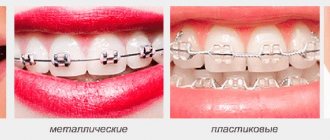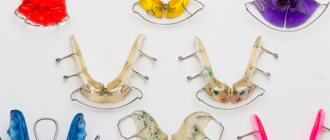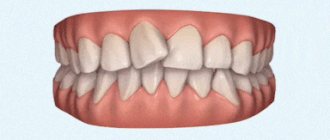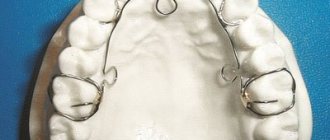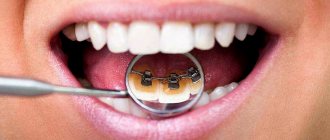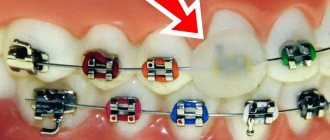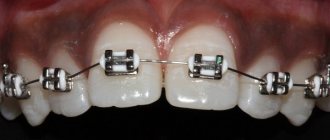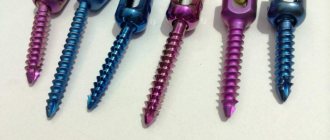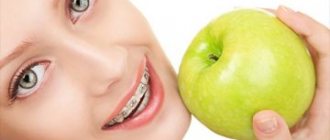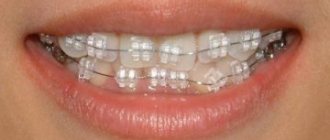An orthodontic plate is a special device necessary to correct the bite and teeth. The design includes the plate itself, a metal arc and fasteners. Metal parts are made of titanium and nickel alloy. The vestibular plate is made individually for each patient, based on the anatomical features of the jaw, the degree of curvature of the dentition and the desired result. The plate is made on the basis of previously taken impressions of the patient’s jaw.
Orthodontists at the 32 Dent clinic specialize in installing individual plates for the correction of pathologies in children and adults. Here we provide an integrated approach, clear control of the doctor, proper motivation, and a guarantee of results.
How does a vestibular plate work?
Each plate has a “memory”, thanks to which the metal arcs still return to their original positions. This is important in the process of correcting the bite, when the arch “moves” the patient’s jaw bones and teeth to the required correct parameters. The orthodontist’s task is to select a plate with metal elements of such thickness and tension force that it works effectively in each specific case.
The plate may also have a special “clasp” that corrects its position during the treatment period. The lock is tightened at certain intervals, thereby correcting the bite.
When is the record used?
- for the treatment of abnormal position of teeth (canines and incisors);
- to correct a situation where a patient has had a tooth removed that had erupted out of place;
- to obtain a healthy bite without removing healthy teeth.
Metals
For partial removable prosthetics, for example, in the manufacture of clasp dentures, metal alloys are used. Usually it is an alloy of chromium with cobalt or nickel, but sometimes titanium is used.
The use of metals as a material for fixed prostheses: crowns and bridges is widespread. They are made from precious metals: gold, platinum, palladium or the above alloys. Metals are also used to make inlays.
Metal ceramics
Nowadays, metals and their alloys are used mainly as a framework for metal-ceramics.
Cladding metal with ceramics solves the main problem of metal structures – galvanosis
. Reacting with each other, metals cause a chemical reaction, which is expressed in a metallic taste in the mouth, irritation of the mucous membranes, and burning of the tongue. Ceramic insulates the metal, preventing galvanization. Structures made from noble metals are bioinert and do not cause galvanosis.
The main disadvantage of metal-ceramics: the metal shines through and the tooth does not look natural. In addition, the junction with the gum often turns blue, which spoils the impression of a smile. Therefore, metal-ceramics are preferred to be used on chewing teeth, where aesthetics are not as important as strength.
Metal-plastic
Used for temporary crowns. The base is made of metal, and a plastic overlay is fixed on top. High-quality crowns can last 2-3 years
, but eventually they will have to be changed. They are fragile, easily painted, and cracked.
Ceramics (dental porcelain)
Ceramic products help solve aesthetic problems and reduce the risk of galvanosis. Conventional dental porcelain is too fragile, so technologists have developed innovative materials:
- leucite-based glass ceramics – Empres
s; - glass ceramics based on lithium disilicate – E-max
; - microceramics based on zirconium silicate – Ceramage
.
Dental dentures made of ceramics:
- imitate tooth enamel in color and light refraction;
- do not cause allergic reactions and galvanosis;
- thinner than metal ones, teeth are not sharpened so much;
- do not require depulpation;
- fit tightly to the gums.
Zirconium dioxide
A special feature of zirconium is its hardness. This is the most durable dental composition. Can be used on chewing teeth. Zirconium is an inert material, it is hypoallergenic and does not cause irritation. Products made of zirconium do not conduct heat and cold well; they will help patients with increased tooth sensitivity.
Zirconium dioxide does not transmit light as well as glass ceramics, so it is particularly white. Disadvantages include the ability to wear away antagonistic teeth.
Metal-free compounds are used for the manufacture of bridges, crowns, veneers, and inlays.
Comparison of compositions for fixed dentures
| Functions | Metal ceramics | Metal-free compounds |
| Wear resistance | High | High |
| Life time | 8-10 years[1] | 8-10 years[1], from zirconium - up to 15 years |
| Aesthetics | Metal shines through the ceramic (blue edge at the gum) | Absolute imitation of natural enamel |
| Care | Thorough, with regular professional cleaning | Tight fit to the gum makes care easier |
| Biocompatibility | May cause allergies, galvanosis | Hypoallergenic, bioinert |
| Weight | Massive | Lungs |
The doctor decides what material to use for dentures after examination and collection of information.
- Alekperov R.B. Orthopedic dentist
Question:
Is it true that nylon deteriorates quickly and the prosthesis needs to be replaced?
Answer:
Nylon prosthesis requires careful care using gentle, non-abrasive compounds and a soft brush. If hygiene rules are not followed, the surface of nylon becomes porous and rough. It is not advisable to use such a prosthesis
- Sapronov D.O. orthopedic dentist
Question:
Is ceramic only suitable for anterior teeth?
Answer:
The strength properties of all-ceramic prostheses determine the preferred scope of their application for the frontal zone.
< Previous Next >
Why do patients choose vestibular plates? Advantages and disadvantages of designs
Pros of orthodontic plates:
- The price is within reason.
Low cost compared to the same braces (the cost of the design ranges from 8,000 to 10,500 rubles per course of treatment);
- Easy to wear and hygienic.
The patient can easily remove it from the mouth before eating, wash it, and put on the device independently.
- Eat what you like.
When wearing plates, there are no restrictions on food consumption. You can eat meat, hard and sticky foods. The design is simply removed before eating and put on afterwards. - Correction of the position by a doctor or independently.
During dental treatment, you can always adjust the tension force. This can be done by the patient himself, tightening the lock, or by the dentist during a follow-up visit.
- Optimal aesthetics.
People around see only a metal arc on the teeth, and with close contact, the interlocutor practically does not notice the plate.
The nuances of using orthodontic plates for teeth:
- Wear for about 2 years.
The estimated duration of treatment is 20 months or more, depending on the pathology of the bite. In any case, the treatment is worth it so that after about two years the teeth are straight and healthy.
- Some discomfort for the patient.
It is felt immediately after installing the device on the teeth or after tightening it, but patients quickly get used to this position.
- It is impossible to correct serious pathologies.
Unfortunately, vestibular plates are not able to correct serious pathologies of the bite and teeth. In this case, orthodontists recommend treatment with braces.
- It all depends on the patient's motivation.
This is especially true for children who do not always strictly follow doctors’ recommendations for regularly wearing plates. In addition, the plate must be worn on the teeth for 20–22 hours, and not every child agrees to follow this iron rule.
Basic requirements for material for dentures
Although a wide variety of materials are used in orthopedics, they all must meet certain requirements: to be durable, functional and attractive in appearance. That is why gold crowns and iron teeth are a thing of the past. Alas, there is no ideal alloy. Typically, more brittle ones imitate natural enamel better than harder ones. But orthopedists strive to achieve balance in everything. Regardless of what materials dentures are made from, they must:
- Withstand exposure to aggressive environments. Sour, sweet, salty - all these are chemical irritants that negatively affect the prosthesis. Maintaining its functions despite an unfavorable environment is one of the important requirements for the composition.
- Do not interact with food or change its taste
- Be comfortable to wear
- Look natural
- Have no smell or taste
Types of orthodontic plates
Depending on the type of construction, individual vestibular plates can be removable or non-removable. We will not consider fixed structures, since they are used extremely rarely in orthodontic practice.
7 types of removable orthodontic vestibular plates:
1. Frenkel system – a removable plate with protective elements for lips and cheeks;
2. For one jaw – a vestibular plate, which is used to correct the position of single teeth;
3. Bruckle system - a plate designed to correct a strongly protruded chin;
4. A plate equipped with a retraction arc - a device that is necessary to correct the position of the incisor teeth;
5. The Andresen-Goipl system, affecting the lower and upper jaws;
6. A removable plate with a push element is designed to expand the patient's upper jaw;
7. A plate with a process, necessary for the correction of one tooth (most often incisors).
Treatment mechanism
Removable orthodontic appliances are divided into devices:
1 . Mechanical action - influence the teeth and dentition through mechanical elements. These are different types of plate devices.
2. Functional action. - regulate impaired functions that affect the formation of bite, and due to this prevent or eliminate the development of dental anomalies. This group includes trainers, function regulators, and individual functional devices.
3. Combined - combines mechanical and functional properties at the same time.
Removable orthodontic appliances of standardized systems are selected by the doctor according to size, rigidity and other parameters, while individual ones are made from impressions in a dental laboratory. Most often, such structures are used in childhood and adolescence, helping the jaws to form in the desired closure. Thanks to this, permanent teeth are able to grow in the correct, physiological position. In adults, these structures can be used as additional methods in correcting malocclusion.
Removable orthodontic appliances primarily eliminate the causes of malocclusion, allowing the teeth to return to their place on their own. Plates and trainers also solve other problems: they improve the functions of speech, breathing and swallowing, correct the position of the tongue, and reduce the pressure of the jaw muscles on the teeth. Often they are indispensable in order to consolidate the results of treatment with braces.
Timely treatment with removable appliances for correcting occlusion at the stages of temporary and mixed dentition can prevent the development of malocclusions, facilitate and shorten the treatment time for this disease during the period of permanent dentition.
Often, timely treatment during the period of temporary and mixed dentition leads to the formation of a correct permanent dentition.
Plates for correcting “milk bite” for the youngest children
The bite can also be corrected for young children. There are a number of orthodontic plates for this purpose:
plate with a wire shutter - used to correct an open bite, when when the jaws are closed, there is a gap between them;
a plate with a special “bead” - a design that is used in case of incorrect position of the tongue, and, consequently, pronounced speech defects;
classic plastic plate - recommended for frequent mouth breathing (breathing correctly - through the nose), the habit of thumb sucking;
vestibular with a special element in the form of a visor - with underdevelopment of the lower jaw due to thumb or pacifier sucking.
The need to correct the bite of children with primary teeth is determined by a pediatric orthodontist. As a rule, this is necessary for genetic predisposition, jaw injuries, obvious orthodontic deviations, which are easier and faster to correct at this age. Plates for small children are equipped with special plastic holder rings to prevent accidental passage of the plate.
How should you wear the record? Basic rules and expert recommendations
The approximate period of correction using a plate ranges from several months to two and a half years.
Most of the time, the vestibular plate is in the mouth: always at night, as well as during the day with breaks for meals. The approximate total time the tablet remains in the mouth is 20-23 hours.
While the patient is eating or performing dental hygiene procedures, the plate is placed in a special container with liquid. It is always washed after removal from the mouth and before insertion.
The record should be thoroughly cleaned daily as part of standard hygiene rituals to prevent plaque from forming on the metal and plastic parts.
Polymers (plastics)
The use of polymers in orthopedics has become a real revolution. Plastic structures are still one of the most in demand. Most often, polymers are used for the manufacture of complete or partial removable dentures and as temporary structures.
Acrylic
This is inexpensive, lightweight plastic. It is resistant to chemical influences and holds its shape well. Acrylic dentures are easy to manufacture and can be repaired. Unfortunately, it is hygroscopic and easily becomes covered with microcracks in which bacteria accumulate. Acrylic systems take a long time to get used to and often cause discomfort. These shortcomings are easy to accept, but acrylic plastics contain monomers, substances that cause allergic reactions. This is the main disadvantage of acrylic. Before prosthetics, an allergy test is required.
Nylon
The problem of allergies is solved by thermoplastics - plastics that do not contain monomers. The most common of them is nylon. It is very durable, but at the same time elastic. Does not lose color even after several years of use. Nylon systems do not rub the mucous membrane and take up little space in the mouth. They get used to them faster than acrylic ones.
But nylon, as a material for removable dentures, also has disadvantages. Due to its flexibility, nylon easily peels away from the sky. The chewing load is distributed unevenly. Working with nylon is more difficult; products from it are not made everywhere.
AcryFree
Technologists have long tried to find a middle ground between acrylic and nylon, and they succeeded. A modern material for the manufacture of prostheses, AcryFree, combines the advantages of both polymers. It is tougher than nylon but softer than acrylic. Moderate hardness ensures uniform chewing load. Although AcryFree cannot stop bone loss, it does significantly slow down bone loss. Thermoplastic does not contain monomers, which means it does not provoke allergic reactions. The manufacturing method is injection molding, which eliminates the formation of micropores.
Disadvantages include a long period of adaptation, the need for special care, and the risk of clasp breakage.
Comparison of polymers
| Properties | Acrylic | AcryFree | Nylon |
| Presence of allergens | Yes | No | No |
| Price | Low | Average | High |
| Elasticity | Low | Average | High |
| Probability of failure | High | Average | Low |
| Possible repairs | Yes | Yes | No |
| Risk of loosening adjacent teeth | High | Short | Short |
Which one to choose is decided by the patient and the doctor after the examination.
How to motivate children to wear an orthodontic plate?
- Demonstrate the result in 3D format so that a person sees his teeth after treatment and understands the importance of such changes;
- Convey all the benefits of wearing a plate: a beautiful face, clear speech, self-confidence, the ability to walk more often and attend clubs without missing out due to colds, straight and flawless teeth, proper development;
- It is important to approach treatment in a playful way, to perform myogymnastics in a fun format. The orthodontist will tell you about this when drawing up a treatment plan.

